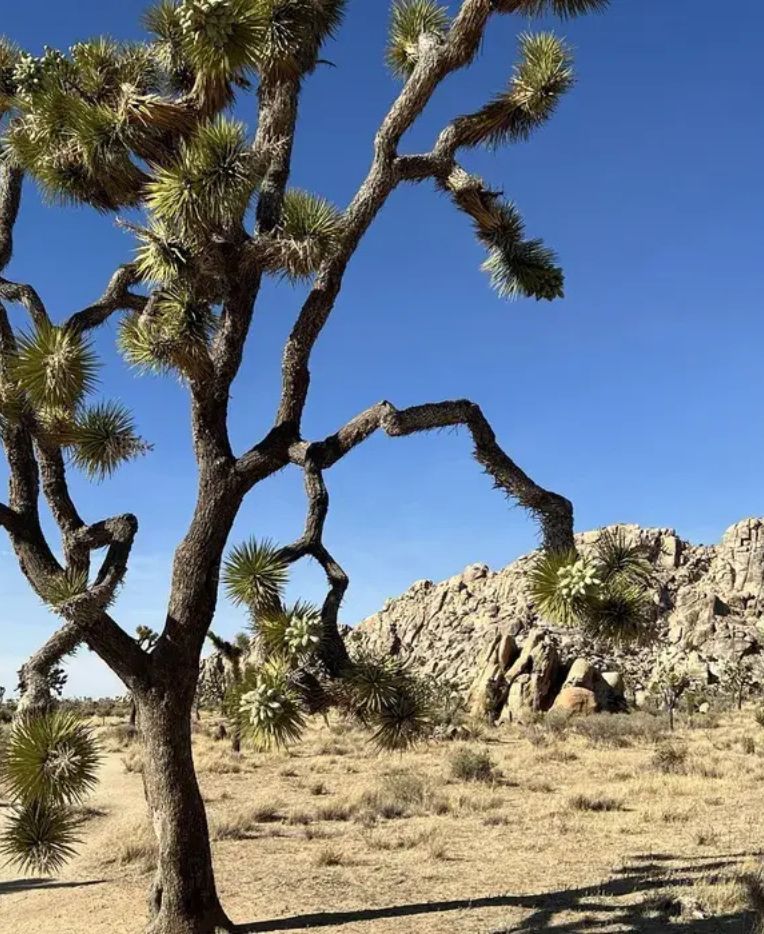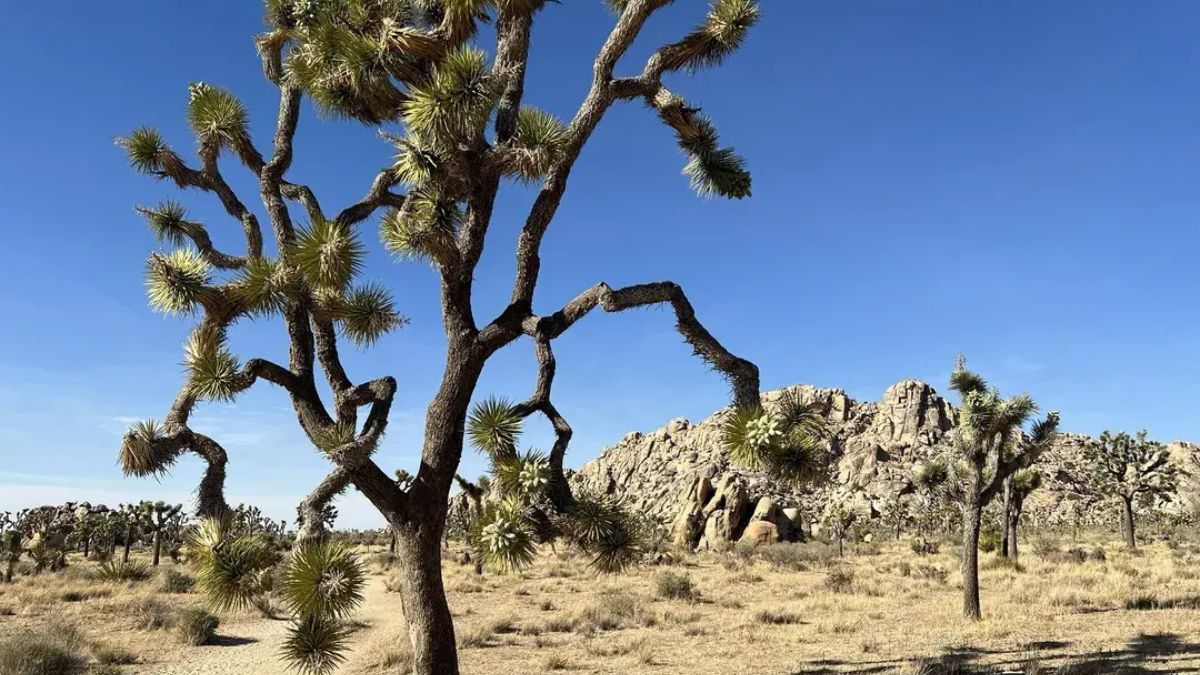Introduction Boy Scout Trail
Boy Scout Trail in Joshua Tree National Park is located relatively close to Palm Springs, California,The is a paradise for hikers, campers, and nature enthusiasts. Known for its dramatic desert landscapes, massive rock formations, and the iconic Joshua Trees, the park offers numerous trails that cater to every level of hiking expertise. Among its many offerings, the Boy Scout Trail stands out as a must-do for adventurers looking for a long, scenic hike that showcases the best of what the park has to offer. Whether you’re planning a day hike or an overnight backpacking trip, the Boy Scout Trail in Joshua Tree promises an unforgettable desert experience.
How Long is the Boy Scout Trail in Joshua Tree?
The Boy Scout Trail in Joshua Tree National Park is 8 miles (12.9 kilometers) one way, making it a 16-mile (25.7 kilometers) round trip if you plan to hike it as an out-and-back trail. For hikers interested in a one-way adventure, arranging a car shuttle at either end of the trail is recommended. The average time to complete the trail one way is around 4 to 6 hours, depending on your pace and the number of stops you make for photos or rest.
The trail connects the Indian Cove Backcountry Board in the north to the Keys West Trailhead in the south. The elevation change is minimal, making it accessible for intermediate hikers, although the length and exposure to desert conditions require proper preparation. Whether done in one direction or as a round-trip hike, the Boy Scout Trail offers an immersive journey through the heart of the park.
Trail Overview and Key Highlights
The Boy Scout Trail is known for its diverse terrain, unique rock formations, and stunning views of the Mojave Desert. Starting from either trailhead, hikers will experience a variety of desert ecosystems, including flat sandy washes, rocky paths, and sections surrounded by the iconic Joshua Trees.
- Starting Point (South): Keys West Trailhead
- Ending Point (North): Indian Cove Backcountry Board
- Difficulty Level: Moderate
- Elevation Gain: Approx. 300 feet
- Trail Type: Point-to-point (or out-and-back)
The first few miles of the trail are relatively flat and easy, allowing hikers to warm up as they enjoy the desert surroundings. As the trail progresses, it becomes more rugged and remote, offering a true backcountry experience. Rock formations and boulder piles add a touch of adventure, and the expansive desert views are a reward for every mile hiked.
Navigation is straightforward, with clear trail markers and a well-defined path. However, carrying a map or GPS device is highly recommended, especially for those hiking in low visibility or early morning/late evening hours.
Scenery and Natural Features
Hiking the Boy Scout Trail offers a front-row seat to some of Joshua Tree’s most iconic natural features. The landscape transitions from high desert to lower elevations, showcasing the diversity of plant life and geological formations that make the park unique.
- Joshua Trees: Tall, twisted trees that dot the landscape and give the park its name
- Rock Formations: Giant boulders and monzogranite rock piles create surreal desert vistas
- Cactus Gardens: Clusters of cholla and barrel cacti add texture to the scenery
- Desert Wildlife: Look out for jackrabbits, lizards, and occasionally desert tortoises
Photography enthusiasts will appreciate the golden hour lighting at sunrise and sunset, which casts a warm glow over the desert floor and highlights the contours of the rock formations. The trail offers countless opportunities for dramatic landscape photos.
Best Time to Hike the Boy Scout Trail
The best time to hike the Boy Scout Trail is during the spring (March to May) and fall (October to November) months. These seasons provide moderate temperatures, making for a more comfortable hiking experience. Daytime highs range between 60°F to 80°F (15°C to 27°C), while nights can be cool but manageable.
Avoid hiking during the peak summer months (June to August), when temperatures can soar above 100°F (38°C), posing serious risks of heat exhaustion and dehydration. Winter hiking is possible, but early morning and nighttime temperatures can drop below freezing, especially in higher elevations.
Plan your hike for early morning or late afternoon to avoid the midday heat. Always check the weather forecast before heading out and carry plenty of water regardless of the season.
What is the Most Beautiful Hike in Joshua Tree?
While beauty is subjective, many seasoned hikers and park visitors consider the Boy Scout Trail to be among the most beautiful hikes in Joshua Tree National Park. Its appeal lies in the variety of landscapes, solitude, and the immersive desert experience it offers over a longer distance.
Compared to popular trails like:
- Hidden Valley Trail (1 mile loop with scenic rock formations)
- Ryan Mountain Trail (3 miles round-trip with panoramic summit views)
- Barker Dam Trail (1.3 miles with a historic water reservoir)
…the Boy Scout Trail offers a less crowded, more remote, and aesthetic desert hike that showcases the best of Joshua Tree’s ecosystem.
The dramatic contrast between open desert plains and rugged rocky sections provides a visual feast for hikers. The gradual change in elevation and vegetation gives the impression of walking through multiple biomes in a single trail.
Wildlife and Safety Tips
When hiking the Boy Scout Trail, it’s essential to be aware of the local wildlife and practice safety precautions to ensure a successful trip.
Wildlife
- Reptiles: Desert iguanas, side-blotched lizards, and the occasional rattlesnake
- Birds: Cactus wrens, hawks, and roadrunners
- Mammals: Jackrabbits, coyotes, and bighorn sheep (rare sightings)
Safety Tips
- Stay Hydrated: Carry at least 3–4 liters of water per person
- Sun Protection: Wear a wide-brimmed hat, sunglasses, and high SPF sunscreen
- Navigation: Download offline maps or carry a physical map
- Tell Someone: Inform a friend or family member of your hiking plan
- First Aid: Pack a basic first aid kit and emergency whistle
Always watch your step, especially near rocky sections where rattlesnakes may be sunbathing. Avoid hiking during midday in summer and take breaks in shaded areas whenever possible.
How Long of a Hike is the Joshua Tree?
Joshua Tree National Park offers a wide range of hiking options, from short 0.5-mile nature trails to long-distance backcountry treks. The total length of hiking opportunities in the park spans over 100 miles of marked trails, making it a hiker’s paradise.
Popular hikes by distance include:
- Barker Dam Trail: 1.3 miles
- Hidden Valley Trail: 1 mile
- Ryan Mountain: 3 miles
- Lost Horse Mine Loop: 6.5 miles
- Boy Scout Trail: 8 to 16 miles (depending on route)
- California Riding and Hiking Trail: 37 miles (multi-day hike)
The Boy Scout Trail stands out as one of the longer day hikes, or can be part of an overnight backpacking adventure. It represents the best of mid-distance desert trekking and is ideal for those looking for a full-day immersive hiking experience.
Camping on the Boy Scout Trail
Backcountry camping is allowed along the Boy Scout Trail, offering an excellent opportunity for a multi-day adventure in Joshua Tree’s wilderness. To camp overnight:
Requirements
- Free Backcountry Permit: Required and available at trailhead registration boards
- Camp 1 Mile from Roads: Ensure your campsite is at least 1 mile from the nearest road or trailhead
- No Campfires: Fires are not allowed in the backcountry; use a backpacking stove
Recommended Campsites
- Near Willow Hole Junction
- Open desert flats 5–6 miles in from the trailhead
Camping along the trail allows for stargazing in one of the darkest skies in California. Night temperatures can drop rapidly, so be prepared with adequate layers and a quality sleeping bag.
What is the Hardest Hike in Joshua Tree?
Joshua Tree National Park has several challenging hikes, but among the hardest are:
1. California Riding and Hiking Trail
- Distance: 37 miles
- Duration: 2–3 days
- Terrain: Varied, remote, and physically demanding
2. Ryan Mountain Loop
- Distance: 3 miles round trip
- Elevation Gain: 1,070 feet
- Steep ascents with limited shade
3. Quail Mountain
- Distance: 12+ miles round trip (no official trail)
- Navigation required
- Highest peak in Joshua Tree at 5,813 feet
In comparison, the Boy Scout Trail is considered moderate. Its main challenge lies in its length and exposure, not in steep climbs or technical terrain. For experienced hikers seeking a tough but rewarding hike, the Boy Scout Trail offers the right balance between challenge and enjoyment.

What to Pack for the Boy Scout Trail
Proper preparation is key for a successful hike on the Boy Scout Trail. Use the following gear checklist:
Essentials
- Backpack (20–30L)
- Minimum 3 liters of water
- High-calorie snacks
- Sunscreen and lip balm with SPF
- Hat and UV-protection sunglasses
- Trail map or GPS device
Clothing
- Moisture-wicking base layers
- Lightweight long-sleeve shirt
- Hiking pants or shorts
- Sturdy hiking boots or trail shoes
Extras
- Emergency whistle
- First aid kit
- Headlamp or flashlight
- Extra socks
- Lightweight rain jacket (if hiking in fall/spring)
For overnight hikes, add:
- Tent or bivy sack
- Sleeping bag (rated for 30°F or lower)
- Cooking system and utensils
- Trash bag (Leave No Trace)
Getting There and Parking Info
Southern Trailhead (Keys West)
- Accessed via Park Boulevard
- Located near Keys View Road
- Ample parking and restrooms available
Northern Trailhead (Indian Cove)
- Accessed via Indian Cove Road
- Limited parking; arrive early
- Trailhead located past the Backcountry Registration Board
There are no shuttle services between trailheads, so plan transportation accordingly if hiking one way. Car shuttles or ride shares are commonly arranged among hikers.
Leave No Trace and Conservation
Joshua Tree’s fragile desert ecosystem requires mindful hiking and strict adherence to Leave No Trace principles:
- Pack out all trash
- Stay on the trail
- Avoid damaging vegetation
- Do not disturb wildlife
- Camp only in permitted zones
Preserving Joshua Tree ensures future generations can enjoy its natural beauty. Always leave the trail better than you found it.
FAQs
Is Boy Scout Trail dog-friendly?
No, dogs are not allowed on park trails for their safety and to protect wildlife.
Are permits required for the Boy Scout Trail?
Permits are not required for day hikes. For overnight camping, a free backcountry permit is necessary.
Is there cell phone reception on the trail?
Limited to no reception. Carry a GPS or offline map.
Is there water available on the trail?
No. Bring all the water you need—at least 1 gallon per person for day hikes.
Final Thoughts and Hiker Reviews
Hikers consistently rate the Boy Scout Trail as one of the most rewarding, scenic, and immersive trails in Joshua Tree National Park. Its length, combined with diverse landscapes and solitude, makes it a top choice for experienced day hikers and backpackers.
Whether you’re exploring the desert for the first time or revisiting this remarkable park, hiking the Boy Scout Trail is a bucket-list experience that showcases the true essence of desert beauty, adventure, and tranquility.
Read More:- Black Mountain Trail to the Fire Lookout Complete Hiking Guide

